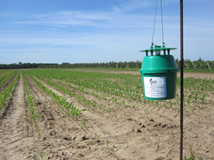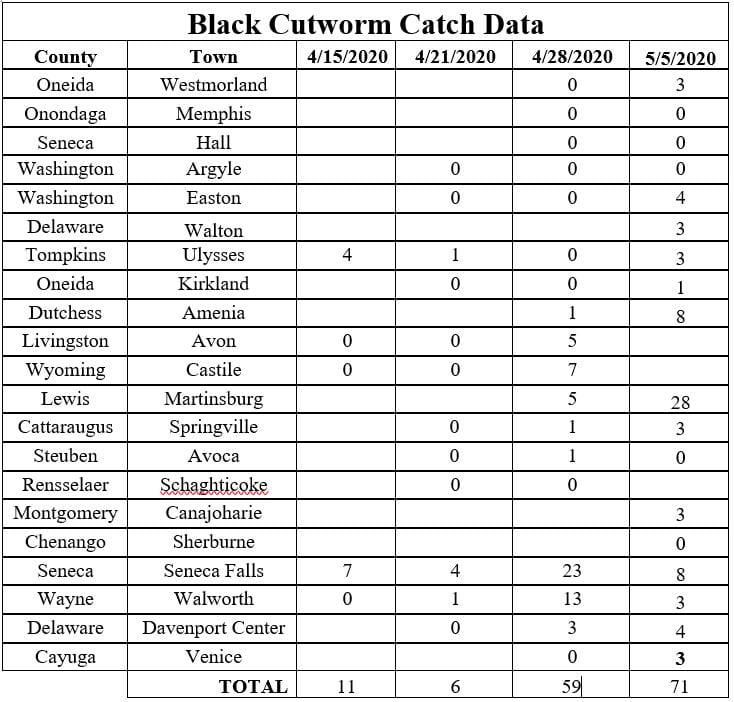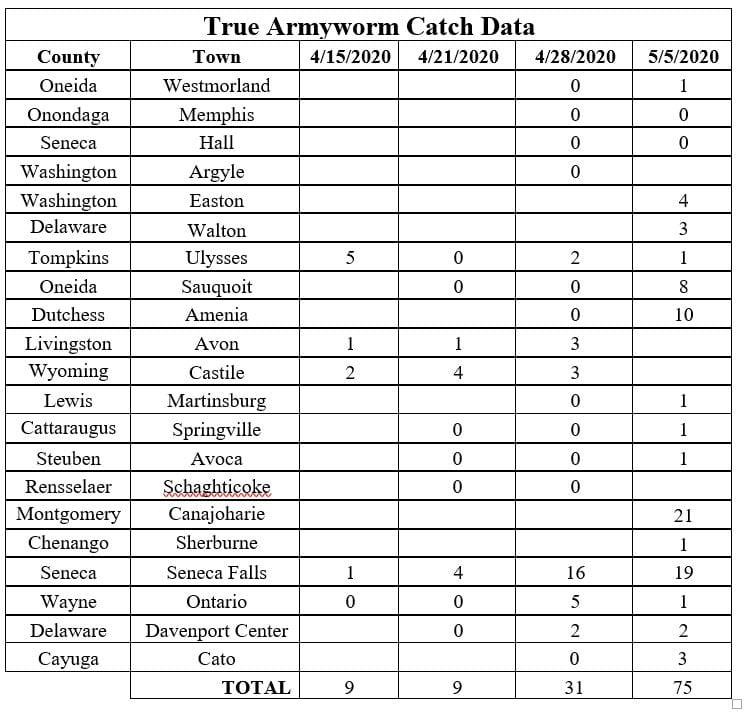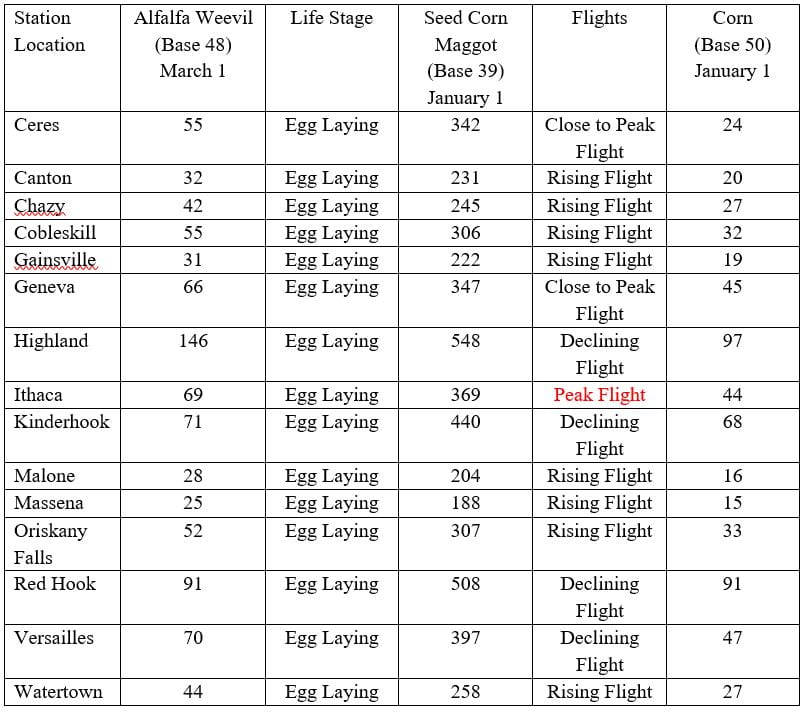May 8, 2020
Volume 19: Number 1
Contents
View from the Field
It is that time of year again when we pull out the sweep nets, pocket our 20x hand lens, throw collection vials, shovels, soil probes, soil thermometers, tape measures, and pest-related resources into the vehicle and head to the field. The question will be “what will we find this season?” Western bean cutworm, seed corn maggot, gray leaf spot, western bean cutworm, common ragweed, northern corn leaf blight, potato leafhopper…….. and so on? This means it is time to start the NYS IPM Weekly Field Crops Pest Report. As you may already know this is the 19th year of the publication. This publication would not exist without your help and observations from the field. When we all share information it strengthens our pest-related alerts and efforts statewide.
The NYS IPM Field Crops Pheromone Trapping Network has caught black cutworm and true armyworm moths the last several weeks. We now have a network of extension educators and agricultural professionals with 42 traps statewide in 20 counties that are monitoring for black cutworm and true armyworm moths migration into NYS. We have caught low to moderate numbers of black cutworm and true armyworm moths. For more information on black cutworm and true armyworm, please refer to the following article: NYS IPM Field Corn Pheromone Trapping Network for 2020 Caught Moths
Dr. Gary Bergstrom reports that wheat spindle streak mosaic virus is present in some wheat fields in Western NY. He states that there are current cultivars that are resistant to the virus. For more information on this virus please refer to the following fact sheet: Wheat Spindle Streak Mosaic Virus
NYS IPM Field Corn Pheromone Trapping Data
Each week we will be posting the number of moths caught at each trapping location. We will define an intense trapping week at a specific location when the individual trap caught 20 or more moths. At that point, we will set the biofix date for that trap. The biofix date is the point where we start to calculate the number of black cutworm and true armyworm degree-days. This can help you predict when a damaging life stage of the insect pest might be feeding on your crop and promote scouting. The degree-days for black cutworm, true armyworm, alfalfa weevil, seed corn maggot and base 50 growing degree-days are presented below with the life stage predictions. We will point out when it will be time to check your fields for these insect pests.
Black Cutworm and True Armyworm Catch Data
Degree Day Model for Field Crops Insect Pests in New York
Alfalfa Weevil and Seed Corn Maggot
Black Cutworm and True Armyworm Degree Days
Lifecycle Growth Stages Models for Black Cutworm, True Armyworm, Seedcorn Maggot and Alfalfa Weevil
Black Cutworm Degree Days (Base 50 F) Lifecycle Growth Stages
Degree Days Stage Feeding Activity
0 Moth Capture Egg Laying
90 Eggs Hatch
91-311 1st to 3rd Instar Leaf Feeding
312-364 4th Instar Cutting Begins
365-430 5th Instar Cutting Begins
431-640 6th Instar Cutting Slows
641-989 Pupa No feeding
Source: University of Minnesota Insect Pest of Corn-Stand Reducers Black Cutworm
True Armyworm Degree Days (Base 50 F) Lifecycle Growth Stages
Degree Days Stage Feeding Activity
0 Moth Capture Egg Laying
113 Eggs Hatch
612 Larval stages Leaf Feeding
909 Pupa No feeding
Seed Corn Maggot Flight Degree-Day Model for Egg Laying
| Base Temp = 390 F | Peak 1st Generation | Seedcorn maggot fly free degree days | Peak 2nd Generation | Seedcorn maggot fly free degree days | Peak 3rd Generation | Seedcorn Maggot fly Free degree days |
| degree days | 360 | 810 | 1,080 | 1530 | 1800 | 2250 |
Source: Insect IPM for Organic Field Crops: Seed Corn Maggot by Katelin Holm and Eileen Cullen
Growing Degree Days for Peak (50%) Occurrence of Alfalfa Weevil growth stage:
| Stage |
Degree Days (Base 48 F) |
| Egg | 280 |
| Instar 1 | 351 |
| Instar 2 | 395 |
| Instar3 | 470 |
| Instar 4 | 550 |
| Cocooning | 600 |
| Pupa | 725 |
| Adult Emergence | 815 |
Source: NYS IPM Growing Alfalfa the IPM Way
Clipboard Checklist
General
*Walk fields to check tile flow, check and clear drainage outlets. Look for line breaks
*Note and record location of wet areas on field maps or aerial photo for future tiling considerations and crop decisions, check for areas of soil erosion
*Pre-plant weed evaluation, timing cultivation and/or pre-plant weed management
*Watch for early season weeds: winter annuals, chickweed, henbit, field penny cress, shepherd’s purse, giant and common ragweed, purple deadnettle, lambsquarters, redroot pigweed, velvet leaf, Pennsylvania smartweed, common sunflower, quackgrass, foxtail
Alfalfa:
*Evaluate established legume stands for winter damage (thinning stand, frost heave, brown root rot), determine average alfalfa stand count adjust crop plans if necessary
*Monitor for alfalfa weevil
*Monitor new seedings for Pythium blight and Phytopthora Root Rot.
*Monitor for Alfalfa Snout Beetle (In Oswego, Jefferson, Cayuga, Wayne, Lewis, St. Lawrence, Clinton, Essex, and Franklin counties)
Small Grains:
*Monitor winter grain fields for over wintering survival (snow mold and other cold injury issues), weed issues (such as winter annuals, corn chamomile and chickweed), growth stage, number of tillers
*Check stands for soilborne virus diseases, Wheat spindle streak mosaic and Soilborne wheat mosaic, check for signs of powdery mildew or other maladies, cereal leaf beetle, weed escapes, goose damage
Corn:
*Prepare land and plant corn as conditions allow
*Pre-plant weed evaluation, timing cultivation and/or pre-plant weed management
Soybeans:
*Prepare land and plant soybeans as conditions allow
*Pre-plant weed evaluation, timing cultivation and/or pre-plant weed management
Pastures:
*Check and mend fences as needed.
*Check crop growth
*Monitor fields for invasive species, plants harmful to livestock
*Review/Plan rotation system
Equipment:
*Remove / clean soil and crop debris from equipment
*Arrange for custom weed control or check your own application or cultivator equipment for repairs.
*Carry appropriate / necessary NYS DEC and EPA required documents: (pesticide applicators license, pesticide labels, MSDS sheets, etc.) with application equipment
*Calibrate:
-planting equipment – maintain records on planting rate per field
-manure spreaders – maintain records on amount spread per field
-pesticide application equipment – Check nozzles, pumps, etc., recalibrate pesticide application equipment before use.
Storage:
* Check stored grain bins for temperature, moisture and signs of mold and insects. Aerate, core, transfer grain or treat as necessary
*Check forage allocation and anticipate feed program adjustments as forages from previous year are used up
*Plan where forages should be stored for optimum allocation next feeding season
Dairy Cattle:
*Clean around feeding rings, feed bunks and water sources removing spilled feed and undisturbed organic matter that is favorable fly breeding habitat.






